Stay Informed:
FEATURES
POLITICS
OPINION
BOOKS
THEATER
FILM & DRAMAS
FOOD & DRINK
MUSIC
CREATIVE
WEBTOONS
Shrouded chapter of history revealed
Civilian commission’s research uncovers facts on responsibility for Gwangju massacre | By Tim Shorrock (Summer 2023)
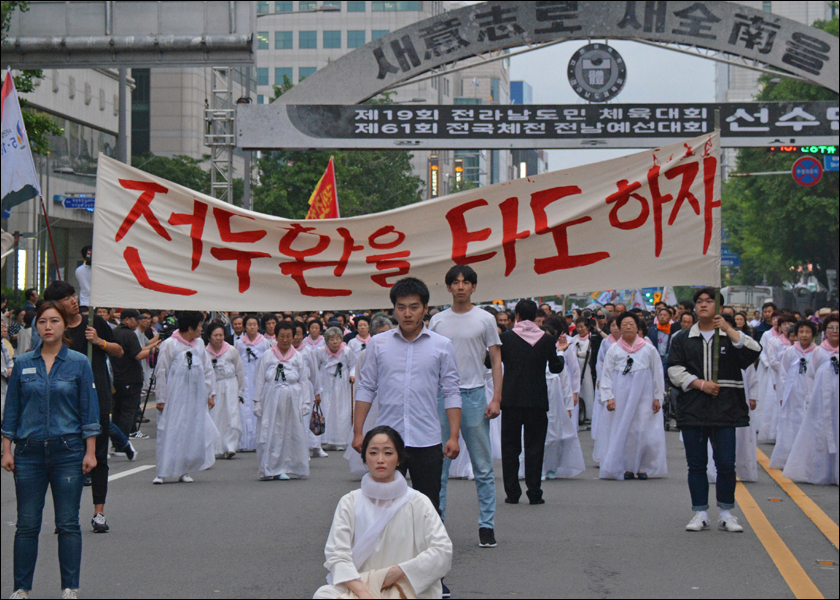 Commemoration of the May 1980 uprising and massacre on the streets of Gwangju. Photo by Stephen Wunrow
Commemoration of the May 1980 uprising and massacre on the streets of Gwangju. Photo by Stephen WunrowEditor’s note: The Cherokee Files archives are KQ contributor Tim Shorrock’s collection of declassified documents on U.S. policy in South Korea during 1979 and 1980. They were obtained between 1991 and 2006 from the Department of State, the Department of Defense, the National Security Council, and the Central Intelligence Agency. They focus on the rolling coups d’etat by Doo-hwan Chun, the Gwangju Uprising, the U.S. response to the assassination of South Korean President Chung Hee Park and other U.S. actions and policies during that time. Shorrock reported this information starting in 1994 in the New York Journal of Commerce and Seoul’s Sisa Journal. Shorrock reports that many of these records are now available in the U.S. The original, hard-copy files are housed at the 5.18 Archives in Gwangju City, South Korea. The writer thanks Jae-Eui Lee, author of the seminal eyewitness account of the uprising, entitled Kwangju Diary, for his assistance in interpreting and understanding the documents on the 1980 uprising.
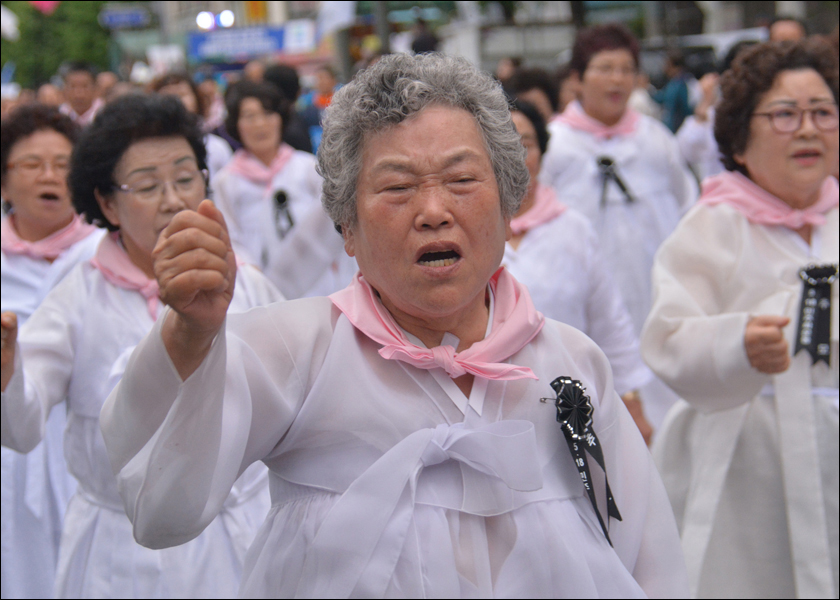 Relatives of those killed or wounded march for justice on the streets of Gwanju during the 5.18 commemoration. Photo by Stephen Wunrow
Relatives of those killed or wounded march for justice on the streets of Gwanju during the 5.18 commemoration. Photo by Stephen WunrowA South Korean truth commission charged with investigating the May 1980 Gwangju Uprising is seeking to identify and report on the military leaders responsible for the mass killing of demonstrators by special forces troops.
The Gwangju Uprising is now considered as a pivotal event in South Korea’s march to democracy, yet for years it was shrouded in mystery and controversy for a number of reasons, including the murky role of the U.S. in the events. The violent military quashing of the pro-democracy movement in that city precipitated civilians’ resistance to martial law. This led to a military armed repression after troops re-took control of the city from its traumatized citizens on May 27, 1980.
The May 18 Democratization Movement Truth Commission was created in 2019 by a special law during then-President Jae-in Moon’s administration in an effort to uncover facts about how the then-military dictator President Doo-hwan Chun was able to unleash a violent attack on civilians involved in the democracy movement in that city, then control and distort the facts of what happened from the outside world.
Since its establishment, the Commission’s research staff has been interviewing former soldiers, democracy activists, and survivors. They have also been using forensic tools, including excavations of graves and DNA testing of remains, more accurately estimate the killed and injured during the seminal event.
Investigators also want to document the origins of the uprising, including research to expose the behavior of military and intelligence agencies during the severe repression that followed the defeat of Gwangju’s citizen army by the U.S.-backed South Korean Army.
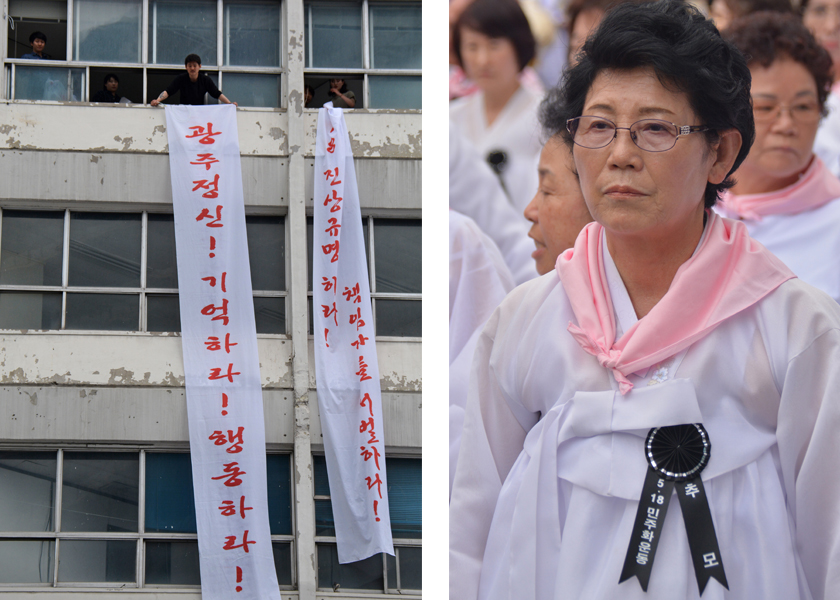 (right) Participants in the commemoration of the Gwangju Massacre reenact hanging banners from the Jeonil building as happened in 1090 and (left) relatives of those injured or killed in the Gwangju Massacre march on the streets during the commemoration. Photos by Stephen Wunrow
(right) Participants in the commemoration of the Gwangju Massacre reenact hanging banners from the Jeonil building as happened in 1090 and (left) relatives of those injured or killed in the Gwangju Massacre march on the streets during the commemoration. Photos by Stephen WunrowThe commission’s focus also includes documentation of human rights violations by the Korean military and police, including: Murders, injuries, and sexual violence; identifying the whereabouts of missing persons and locating secret burial sites; determining the military and intelligence agencies’ distortions and coverups of the democracy movement by Korean military, the intelligence agencies and the Ministry of National Defense; determining responsibility for the helicopter machine-gunning of the Jeonil Building in downtown Gwangju on May 21, 1980; the confirmation or denial of reports, spread in recent years by right-wingers, that North Korean military officers infiltrated the Gwangju movement; and deaths or injuries to military personnel and the police.
In its latest (interim) report, issued on May 17, the commission released testimony that martial law forces continued killing citizens in Gwangju on May 27, even after the official suppression operation had ended. A final report is due out soon.
As reported by the Hankyoreh newspaper, recent revelations show that “the Chun Doo-hwan’s military regime’s claims of exercising its ‘right to self-defense’ to have been false.” The new report contains graphic images, shot by a French photographer, of the bleeding body of Jong-yeon Kim, a 19-year-old student. Kim was shot after he emerged from hiding on May 27 after the supposed end of the U.S.-sanctioned “suppression operation.”
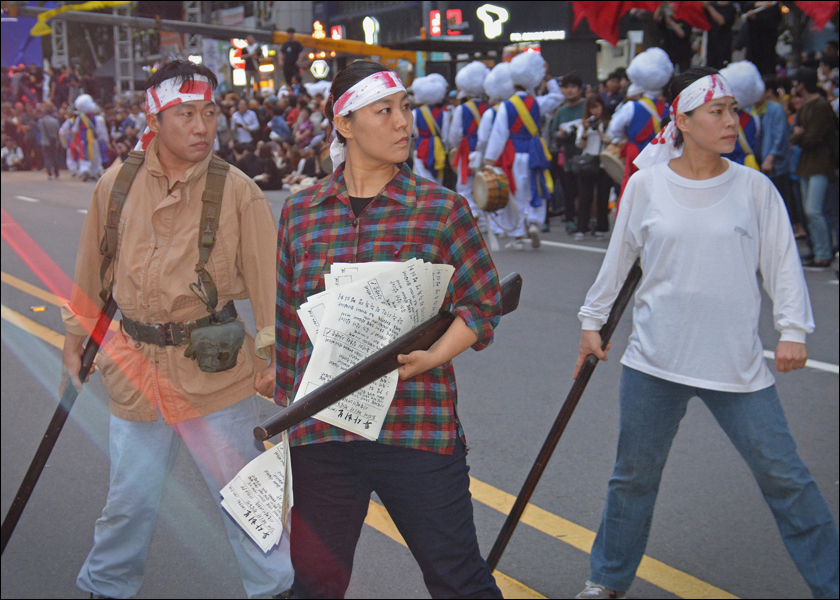 Citizens of Gwangju reenact scenes of the uprising during a May 18 commemoration event. Stephen Wunrow photo
Citizens of Gwangju reenact scenes of the uprising during a May 18 commemoration event. Stephen Wunrow photoU.S. actions under scrutiny
In a significant break from prior investigations of Gwangju, the truth commission has asked the U.S. government to provide more than 200 military and intelligence documents relating to the communications between U.S. and South Korean generals in the U.S.-South Korean Combined Forces Command (CFC) before, during, and after the civilian uprising, top officials said.
Of particular interest are reports and minutes of U.S. military discussions with then-military dictator Chun and the small group of loyalists around him. Now South Korea’s most reviled president, Chun seized control of the country in a rolling coup that began with his violent takeover of the Republic of Korea (ROK) Army in December 1979 and culminated with his declaration of martial law across the country on May 17, 1980. The uprising in South Cholla Province began the next day after Chun’s martial law army occupied parts of Gwangju City.
“Many of these documents are still classified and not disclosed yet,” Seon-tae Song, the commission chairperson, told me in an exclusive interview at his offices in downtown Seoul. These documents are important to the investigation because many of the Korean military documents concerning Gwangju have been “deleted, distorted, or changed,” he added.
Song is a former secretary to the Prime Minister’s office and was an adviser to the 5.18 Special Investigation Committee of the Ministry of National Defense during the Jae-in Moon administration. He said his investigators have also sought relevant military documents concerning the Gwangju Uprising from China, Russia, and Japan through the United Nations High Commissioner for Human Rights (UNHCR).
So far, 91 military and intelligence officials have been prosecuted for their roles in the Gwangju military violence. They have two things in common, Song said: “one, they’re not telling the truth; and two, none have apologized to the victims or the public.” As a result, the commission is working from the “bottom to the top,” starting its interviews with lower-ranking officers and working their way past the rank-and-file to the coup leaders responsible for the bloodshed in Gwangju.
The release of U.S. intelligence reports or internal military communications within the joint command would not necessarily be detrimental to the U.S. or U.S. Forces Korea, the commission said. The Central Intelligence Agency (CIA) and defense intelligence documents and reports, for example, might help the truth commission corroborate or disprove claims or denials about the incident made by the Chun group that controlled the Korean military before and after Gwangju. U.S. documents from 1980 could also be compared to South Korean intelligence reports for accuracy or signs of tampering or falsification.
At the same time, U.S. intelligence on North Korean leader Il Sung Kim and the North-South border at the Demilitarized Zone (DMZ) could disprove the ludicrous claims from right-wing forces that 600 or more North Korean military officers secretly came to Gwangju and helped direct the uprising. For decades, North Korea, the DMZ, and the Korean coast have been the most surveilled spots on earth, watched 24/7 by the most sophisticated spy planes and satellites in the U.S. arsenal. Any signs of North Korean infiltration at the time of Gwangju would have been cause for deep alarm and threats of military action. As I have reported extensively, neither occurred.
Still, the request for U.S. military communications with Korean military and martial law commanders raises sensitive issues for the U.S. The Gwangju Uprising is now considered as a pivotal event in South Korea’s march to democracy, yet for years it was shrouded in mystery and controversy, particularly over the murky U.S. role. The uprising occurred at a time during which the Carter administration was reeling from a string of policy disasters, led by the Iranian hostage crisis that followed the 1979 overthrow the Shah of Iran (who was installed in power by the CIA in 1954). With Iran dominating the headlines in 1980, Carter’s advisers did not want another crisis in Korea. Much of its response to Chun’s coup, therefore, was predicated on the need to avoid “another Iran,” as the meddlesome diplomat Richard Holbrooke said repeatedly at the time.
Despite the state-sanctioned violence May 18 to 21, and the president’s professed focus on human rights, the Carter administration ultimately sided with the Korean martial law army when it recaptured Gwangju from the civilian militia on May 27. That decision created the worst crisis in U.S.-South Korean relations since 1953, sparking years of anti-American feeling and creating fissures in the bilateral relationship that have never fully healed. Many Koreans would like to see a formal apology from Washington.
They never got one from Chun. In 1996, the former president was tried and convicted on sedition charges for his actions in Gwangju. He was pardoned the next year by President Young Sam Kim at the request of the incoming president, Dae Jung Kim, the former opposition leader who was nearly executed by Chun after his coup. The notorious general died in 2021 denying any involvement in the massacre and without ever apologizing to the city’s people. Recently, his grandson, Woo-won Chun, visited Gwangju and officially apologized to victim’s families for his grandfather’s assault on the city. Since the younger Chun went public, he has also made a series of sensational accusations of corruption against his family and his infamous grandfather.
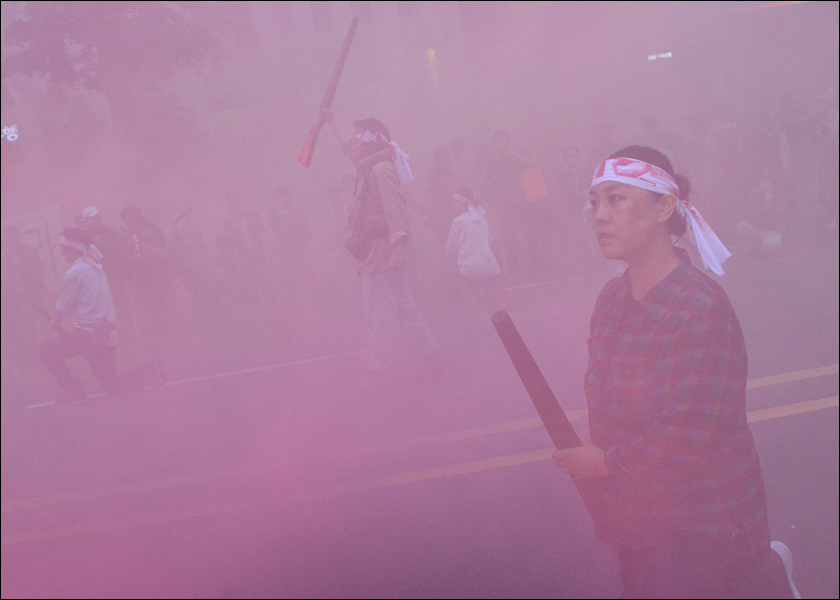 Citizens of Gwangju reenact scenes of the uprising during a May 18 commemoration event. Stephen Wunrow photo
Citizens of Gwangju reenact scenes of the uprising during a May 18 commemoration event. Stephen Wunrow photoWho gave the shooting orders?
One of the key points of the investigation, Song told me, is to determine “who was in charge of the shooting orders” before the armed attacks began on May 21, three days into the uprising.
On May 18, after local police refused to physically attack the pro-democracy demonstrators, Chun’s Special Warfare Command’s paratroopers were ordered to do the job. Over the next three days, in battles all across the city, soldiers used boots, clubs, and bayonets to stomp, beat, and stab people to death. Citizens who protested were chased down into their homes and shot and beaten. By the night of May 20, the city was in an uproar, in a situation the CIA called an “insurrection.”
At around 1 p.m. on May 21, Chun’s troops opened fire on a massive crowd of enraged citizens, bus drivers, and taxi drivers who had encircled them at their headquarters at the provincial capital building; dozens were killed in the fusillade. At this point, Gwangju locals, using weapons seized from nearby police stations and factories, began to shoot back. That evening, Chun withdrew his special forces, and the martial law command drew a tight cordon around the city. According to secret documents seen by commission investigators, as well as interviews they have conducted, Korean army and local commanders on the scene claim they acted out of self-defense. “This is the logic they have used for 43 years,” Song said.
The official death toll of the uprising, once thought to number in the thousands, still stands at around 200. But people in Gwangju believe the true number is closer to 450, with several dozen still unaccounted for. Most of the victims are buried at Gwangju’s National Cemetery, where local citizens and government officials gather every May 18 to commemorate the uprising. Asked about the commission’s conclusions about fatalities, Song, who witnessed the uprising, said the number of missing persons has yet to be determined.
At the time, the national registry of deaths was only 10 years old and unreliable, Song said, and did not account for homeless people and those living on the edge. And strangely, after the wave of killing, many lower-income kids, such as shoe shine boys, “disappeared from the streets,” he said. “So we are very careful about our figures.”
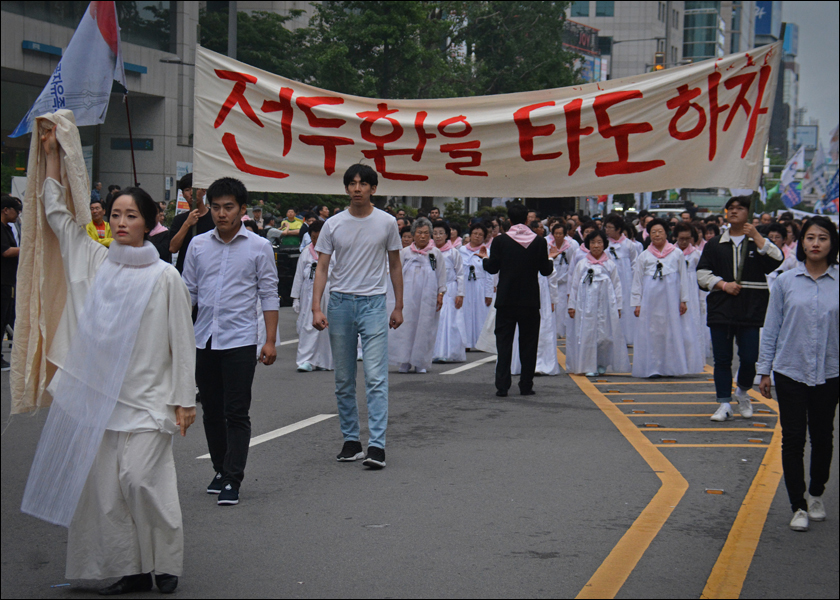 Photo by Stephen Wunrow
Photo by Stephen WunrowThe Cherokee Files, translated
The U.S. documents in question were initially sought through diplomatic channels during the administration of President Jae-in Moon. The request, the commission said, included classified cables and reports from the Central Intelligence Agency, the Defense Intelligence Agency, the National Security Council, the U.S. Eighth Army in Korea, and the headquarters of General John Wickham, former commander-in-chief of the Combined Forces Command and the U.S.-controlled UN Command in Korea. The commission is also seeking classified information on two of the U.S. generals in command positions in the joint command at the time.
Commission officials first requested the American documents in 2020 from the State Department, the Department of Defense, and the CIA through the Korean Ministry of Foreign Affairs. In response, the U.S. Embassy in Seoul and the State Department turned over around 140 diplomatic documents, many of them previously declassified. But since the requests for the military and intelligence documents were made by the commission, “there has been no response from CIA or DOD,” said Dong Il Shin, leader of one of Song’s investigation teams.
In 2019, as one of his first tasks for the commission, Shin translated nearly 4,000 U.S. government documents about U.S. policy in Korea in 1979 and 1980 that I obtained in 1996 under a Freedom of Information Act (FOIA) request. Those documents, later dubbed the Cherokee Files, were the basis of my story in The Journal of Commerce that first revealed that the Carter administration gave a green light to the Korean government to replace the police with Korean army troops to control huge pro-democracy demonstrations that shook Korean cities in the spring of 1980. The truth commission is now using my FOIA documents to corroborate its own findings. Many of them are posted in my archives (an ongoing project).
“Thank you for sharing your documents with us,” Song, who is from Gwangju and was arrested during the uprising, said as we began our interview. “They have been a great help to the work of our commission.”
The most significant document in my collection, the minutes of a White House meeting on May 22, 1980, showed that when U.S. officials decided the uprising was out of control, the U.S. generals running the Combined Forces Command backed Seoul’s use of army troops under the CFC to retake the city on May 27, 1980. A few days later, after the U.S. military (at its own request) deployed key intelligence and naval assets around the Korean Peninsula, the joint command ordered Korean 20th Division soldiers attacked the last holdouts of the citizen army at Gwangju’s Provincial Capital Building and in a nearby complex owned by YWCA.
About 20 people were killed in the final assault, including the chief spokesperson for the citizen army, Song-won Yoon. His body was identified by Norman Thorpe, a reporter for the Asian Wall Street Journal and one of a handful of U.S. and Japanese reporters who witnessed the last days of the uprising. The initial attacks by the paratroopers were captured on film by Jurgen Hitzpeter, a German photographer who, with the help of a Seoul taxi driver, evaded military roadblocks to get into the city. His exploits later became the subject of the famous film A Taxi Driver. I visited his memorial and Yoon’s grave at the Gwangju Cemetery during a two-day stay in Gwangju in April.
My stories about the previously hidden U.S. role in the events of 1980 were published on the eve of Chun’s trial in 1996, and ran simultaneously in the Korean magazine Sisa Journal. My account of U.S. complicity shocked and angered many Koreans, sparking demonstrations at the U.S. Embassy and strong denials from Washington.
But with the sole exception of the Washington Post, my stories and the documents themselves were ignored by The New York Times and other U.S. media. In 2015, the city of Gwangju gave me an honorary citizenship in appreciation for my work.
The Fort Benning connection
In the most significant part of its investigation, the truth commission is seeking to determine the chain of command in the U.S.-South Korean combined forces that organized the Korean military’s takeover of Gwangju after Chun’s forces were driven out of town.
This is where my documents come in. As mentioned earlier, the declassified minutes from the National Security Council show that on May 22 – the day after the mass shooting – President Carter’s national security team made a fateful decision to help Chun’s martial law command put down the uprising.
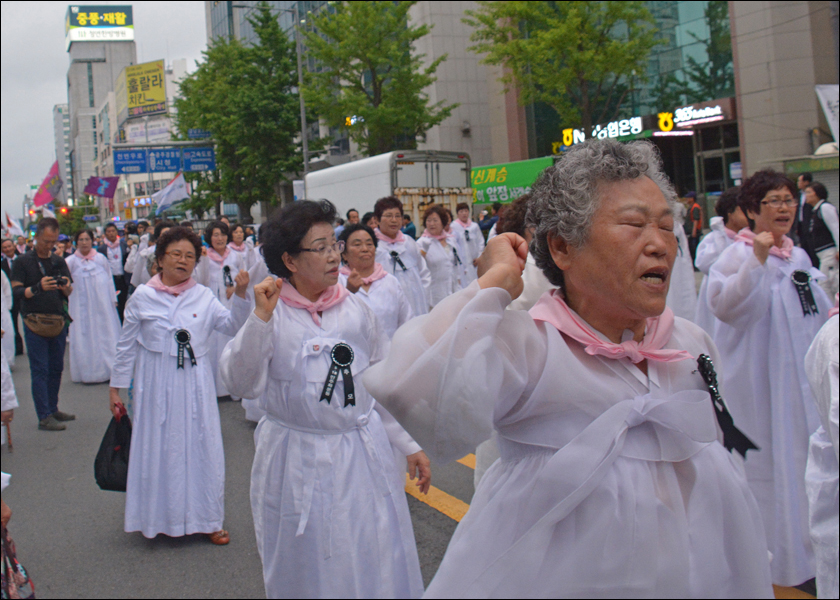 Photo by Stephen Wunrow
Photo by Stephen WunrowThe crucial decision.
As I further reported in 2020, one of the participants in this crucial meeting – a senior official at the Pentagon – later admitted that the decision to restore “order” through the “minimum use of force” rather than seek a negotiated solution was made with the full knowledge that around 60 people had been killed by the paratroopers on May 21 and that Chun himself was responsible. Knowing that, it’s not surprising that many Koreans were bitterly disappointed and angered by the American intervention. As (former president) Dae Jung Kim told me in a 1985 interview while under house arrest in Seoul, “the Gwangju people kept order; paratroopers broke order. You should have criticized the paratroopers’ side, not the Gwangju people’s side. Your attitude was not just, not fair.”
How and why U.S. commanders carried out the White House decision, their ties with Chun, and their communications with their Korean counterparts in the Combined Forces Command, are the biggest unknowns to the investigators. That has led into a dark alley that investigators call “the Fort Benning connection” – that is, the close relationship between Chun and his accomplices with American generals and special forces operatives in Korea.
The truth commission has asked the U.S. government to declassify numerous documents from this time. A key record reads: “The insurrection in Kwangju in Cholla-namdo Province poses a serious challenge to the Martial Law Command’s authority.” The next page summarizes the U.S. position: “The military is trying to negotiate a cease-fire, but it probably will have to use force to end the rebellion… dissidents in other provincial cities and in Seoul may be encouraged by the events in Kwangju. The military would be hard pressed to deal with simultaneous uprisings of the same magnitude in other areas.” (source: The Shorrock Files).
These ties were forged in part at the U.S. Army’s special forces training school at Fort Benning, Georgia, where Chun and his chief accomplice, General Tae Woo Roh, were educated. Later, they were sealed in blood on the battlefields of Vietnam, where both Chun and Roh Korean units in the U.S. war against communist-led insurgents in South Vietnam. During the 1970s, over 300,000 South Korean soldiers were dispatched to Vietnam, at U.S. request. Many of them, like their American counterparts, were responsible for atrocities against civilians.
Chun first emerged as a public figure after the October 1979 assassination of former President Chung Hee Park, whom he served as the commander of the Defense Security Command. He startled his U.S. allies on December 12, 1979, when he and General Tae Woo Roh directed a Korean division stationed near the DMZ to attack the Seoul headquarters of the Martial Law Command. By arresting its commander, Chun effectively seized control of the South Korean Army.
His brazen move represented an unprecedented violation of the U.S.-Korean chain of command, and angered the U.S. Commander of the CFC, General Wickham. But the incident was quickly papered over and forgiven. In the aftermath of the “12/12 Incident,” the U.S. embassy, military, and State Department officials claimed that Chun was an obscure general, little known to U.S. Forces Korea. U.S. officials stated they had been assured at the highest levels that it would never happen again.
But those claims were untrue, according to James V. Young, who was the military intelligence adviser to U.S. Ambassador William Gleysteen at the time. In a 2003 memoir entitled Eye on Korea, Young wrote that Chun was especially close to Col. Donald Hiebert, a U.S. Army Special Forces soldier who served as the U.S. embassy’s defense attache in 1980. Young wrote that “One of [Hiebert’s] frequent associates was a young colonel, Chun Doo Hwan,” adding that “Hiebert had met the colonel in Vietnam, where Chun had commanded a battalion, and had continued their association in Korea. They met rather frequently.” Young wrote that he met Chun for the first time at the U.S. ambassador’s residence in 1972 and several times after that, “usually accompanied by Col. Hiebert.”
The path of the truth commission’s investigation into Chun’s U.S. military contacts is illustrated by a large chart in its offices showing the key names and faces in the U.S.-Korean chain of command during the time of the Uprising. Along with top Korean generals and officials, the chart lists at the top Ambassador Gleysteen, General Wickham, and Robert Brewster, the CIA Station Chief. Their actions at the time are well-known, in part due Gleysteen’s memoir, Massive Entanglement, Marginal Influence: Carter and Korea in Crisis, and General Wickham’s account, Korea on the Brink.
But much less is known about the actions and communications of two American generals listed on the commission’s chart who were directly involved in the military planning for the retaking of Gwangju.
Generals Sennewald and Rosencrans of the CFC
Those officers, whose actions might be illuminated in still-classified CIA documents, were identified as U.S. Army Major Gen. Robert Sennewald, the Assistant Chief of Operations for the U.S.-Korean Combined Forces Command, and U.S. Air Force Lt. Gen. Evan Rosencrans, the deputy commander of U.S. Force Korea and the Chief of Staff of the joint command. Both were deeply involved in the U.S. and Korean military operations (including the declaration of martial law) launched to ensure the security of South Korea after the assassination of Chung Hee Park on October 26, 1979, and in the events after that leading up to Gwangju.
Their initial priority was to protect the country against North Korean intervention. But as the student- and worker-led resistance to military rule picked up in the weeks after Park’s assassination, their tasks quickly turned to internal security and preventing any revolutionary change in the South that might jeopardize the U.S. military presence in Korea and its close relationship with the ROK military.
In Gleysteen’s account, for example, Gen. Rosencrans, the acting commander of USFK, was the first person to alert him to the “signs of unusual activity” within the Korean military on the night of Park’s assassination on October 26. That same night, the Air Force general visited Gleysteen at home, accompanied by ROK Gen. Byong Hion Lew, the deputy commander of the CFC, to deliver the news that Park was dead. Lew, Gleysteen said, was “our principal channel to the Korean army.” He remained in close contact with Gleysteen and Wickham throughout this period.
Gen. Sennewald, described by Wickham as his “very able operations officer in Korea,” played a key role in the final suppression of the uprising as well. According to the commission, a Korean general who was Sennewald’s equivalent as CFC chief of operations has testified that he went to the U.S. general “to get written authorization” of the CFC’s approval for the release of the ROK 20th Army Division for the retaking of Gwangju.
General Rosencrans was in the loop as well. On May 12, 6 days before the onslaught by Chun’s paratroopers, the Air Force general was “informed” by the Korean Minister of Defense that two brigades of Chun’s Special Forces were ready to reinforce the combat police to suppress demonstrations. This disclosure, as I pointed out long ago, directly contradicted a U.S. government “white paper” on the Gwangju crisis that denied U.S. officials had any knowledge of these special forces deployments.
On May 18th, the first day of the uprising, Rosencrans accompanied Gleysteen and Brewster to their meetings with the acting (and powerless) president, Kyu-ha Choi and Martial Law Commander General Hui-Song Lee. In 1989, Lee testified to the first parliamentary investigation of Gwangju that he was formally asked after the 18th by the U.S. command to put off the 20th Division’s assault on the city until May 27th so the Pentagon could get its own assets in place to monitor the operation. Those assets included surveillance planes flown in from Okinawa and the aircraft carrier USS Coral Sea. That later deployment, which was made public at the time, greatly cheered many of the fighters in Gwangju, including Kim Tae Jung, a commission researcher who was a student leader at Gwangju’s Chonnam University during the uprising (he was the MC at the now legendary torchlight rallies held in the city square during its liberation from May 22nd to May 27th).
“People thought the aircraft carrier was a warning to Chun,” he said bitterly. “But we were wrong: it was his watchdog.”
I interviewed Ambassador Gleysteen about his actions in 1996. In the days after May 18, 1980, he told me, he tried to seek a compromise by urging “restraint” on the part of the people of Gwangju and asking the government to apologize for the initial killing, But Gleysteen said he was alarmed by the turn of events inside of Gwangju, particularly when citizens seized arms and emptied one of the local prisons that held several dozen long-term communist prisoners. “The point is, law and order was gone. It was chaos,” he recalled. Incredibly, he added: “Both sides at that point were rather equivalent.”
Gleysteen stoutly defended the U.S. decision to allow the 20th Division to be released from the joint command to enter the city during the early morning hours of May 27. Wickham, he said, told him that the 20th Division had been “very careful and well-behaved” while on martial law duty in Seoul. In addition, “we did not want the special forces used even further, precisely because of what had happened.”
When he received a last-minute request to mediate in Gwangju from a U.S. reporter on the scene, Gleysteen said the 20th Division was “already rolling.” In addition, Gleysteen said he had no idea of the authenticity of the group seeking the mediation, and thus decided not to act. “I grant it was the controversial decision, but it was the correct one,” he said. Gleysteen, whose parents were Protestant missionaries in China, died in 2002.
When I published my stories in 1996, the Clinton administration would not allow anyone to speak on the record about Gwangju. Instead, I was referred to a senior State Department officer for a background interview. Gwangju “was an unspeakable tragedy that nobody expected to happen,” said the official, who was later assigned to a high-level position at the U.S. Embassy in Seoul. “When all the dust settles, Koreans killed Koreans, and the Americans didn’t know what was going on and certainly didn’t approve it.” The State Department, he said, continues to believe that the U.S. “has no moral responsibility for what happened in Gwangju.” That remains the official U.S. position.
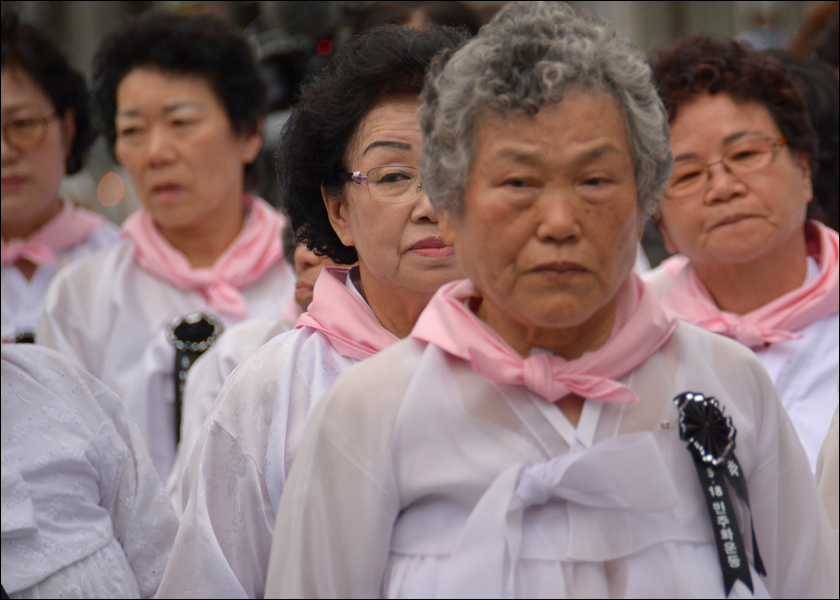 Photo by Stephen Wunrow
Photo by Stephen WunrowWill the Biden administration turn over the documents?
The outstanding request from the commission to the U.S. government for the still-classified military and intelligence documents on Gwangju is unlikely to be answered without public pressure. Suk-yeol Yoon, South Korea’s right-wing, pro-U.S. president, recently partied with President Biden at a lavish White House celebration of their newly invigorated strategic relationship. He is not expected to rock the boat by pushing sensitive requests about American’s past ties with Chun. Many Koreans have dismissed Yoon as being excessively subservient to Biden, particularly after his capitulation to Japan’s Prime Minister Kishida over Korean wartime claims about forced labor.
Moreover, many in Gwangju remember that Yoon’s ruling People’s Power Party includes members who have questioned the legitimacy of the uprising – an attitude made clear by a party banner that was once hanging in front of the commission’s headquarters in Seoul. “What about that Gwangju ‘spirit?’ it mockingly read, a slap at the victims it has accused of falsifying claims for government compensation. As if in response, Gwangju itself spelled out its cynical take of Yoon in a political banner on the main street from the local branch of the opposition Democratic Party. It called for Yoon’s impeachment and, below, declared: “We worry for the future of the nation.”
Back in Washington, Biden and the Pentagon have treated Yoon as a compliant, second-tier ally. With that kind of relationship, they have little incentive to expose their still-secret operations to help Chun and his group retain control over South Korea after killing hundreds of its citizens. While I seek comment from the State Department about the commission requests, perhaps an enterprising reporter from a mainstream outlet (and with access to the usual “intelligence sources”) could ask the White House if the Biden administration is ready and willing to share classified communications between U.S. and South Korean military and intelligence agencies with the truth commission. That could force Biden, or Secretary of State Tony Blinken, to take a position.
Meanwhile, Gleysteen’s ambivalent comments from 1996 will have to stand as the last U.S. word on Gwangju. “Do I regret our decisions? I don’t think so.”
No comments:
Post a Comment